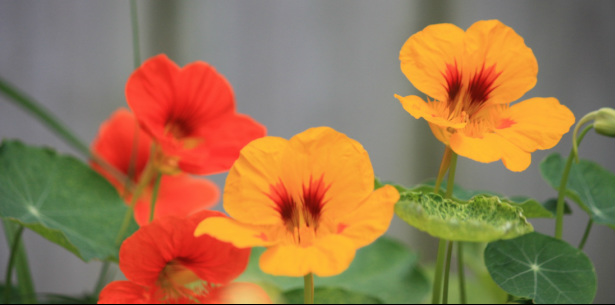How to Grow and Care for Nasturtiums
Nasturtiums have always been one of my favorite flowers. Not because of their attractive foliage or shimmery blooms, but because I simply love their earthy scent that reminds me of days gone by. These old-fashioned flowers have adorned my family's garden for generations. I'm particularly partial to the climbing varieties, but dwarf nasturtiums make excellent additions to containers and window boxes, too.
Nasturtiums may be either single or double bloomed and range from dwarf plants that form a rounded mound 6 to 8 inches tall, to climbers that reach heights of 8 feet. Semi-dwarf plants may reach heights of 2 to 3 feet.
Not only are nasturtiums delightful flowers in shades of yellow, red and gold, they are also edible making them ideal to add to summer salads or as a garnish with summer meals. Of course, if you prefer not to eat your flowers, they make an attractive floral display in vases, too.
Not only are nasturtiums delightful flowers in shades of yellow, red and gold, they are also edible making them ideal to add to summer salads or as a garnish with summer meals. Of course, if you prefer not to eat your flowers, they make an attractive floral display in vases, too.
Growing Nasturtiums
Location: Nasturtiums are sun-loving flowers that require 6 to 8 hours of direct sunlight a day. Although they will grow in less light, blooms are smaller and growth is slow. Plant nasturtiums in a location where they receive adequate light and they will produce an abundance of blooms on robust foliage.
Soil: Nasturtiums aren't particularly fussy about their soil and will grow in nearly any soil as long as they have adequate sun and water. Amending your soil with organic matter, such as well-rotted manure or compost, provides them with slow release nutrients during the summer while improving both aeration and drainage. However, the University of Vermont Extension warns that if soil is too fertile, nasturtiums produce lush foliage with few blooms. When grown in window boxes or containers, a mixture of one part potting soil, one part peat moss and one part perlite works well.
Planting: Plant nasturtium seeds directly in the soil to a depth of 1/2 inch once the soil has warmed and all danger of frost has passed in the spring. Some prefer to soak the seeds overnight, but to be honest, I've never seen a difference in the germination rate or speed from soaking the seeds. Nasturtiums typically germinate easily.
Fertilizing: Nasturtiums do not require frequent fertilizer and may produce large foliage with few blooms if they get too much. Fertilize your nasturtiums sparingly with water soluble fertilizer duing the summer. Use the health and growth of your nasturtiums as a guide to fertilizing them.
Watering: Water nasturtium seeds thoroughly when planting and keep the soil evenly moist until germination occurs in 10 to 14 days. Reduce watering to once or twice a week or whenever your plants show signs of wilting. As a rule, flowers should be watered whenever the soil feels dry to the touch 1 inch below the surface. If you are looking to add an old-time feel to your flower garden or backyard, nasturtiums will do the trick.
